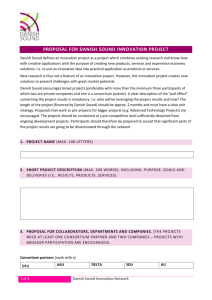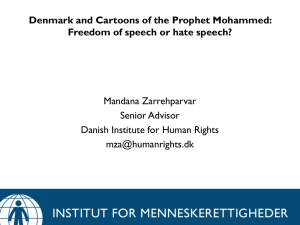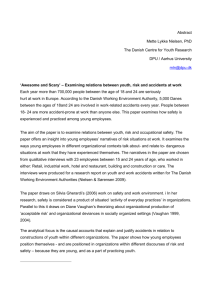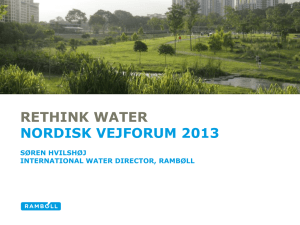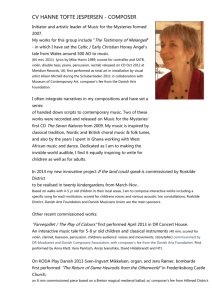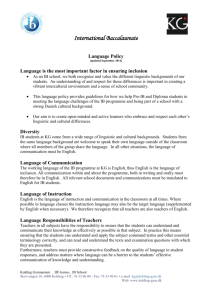Coherent health politics: A societal and individual challenge
advertisement
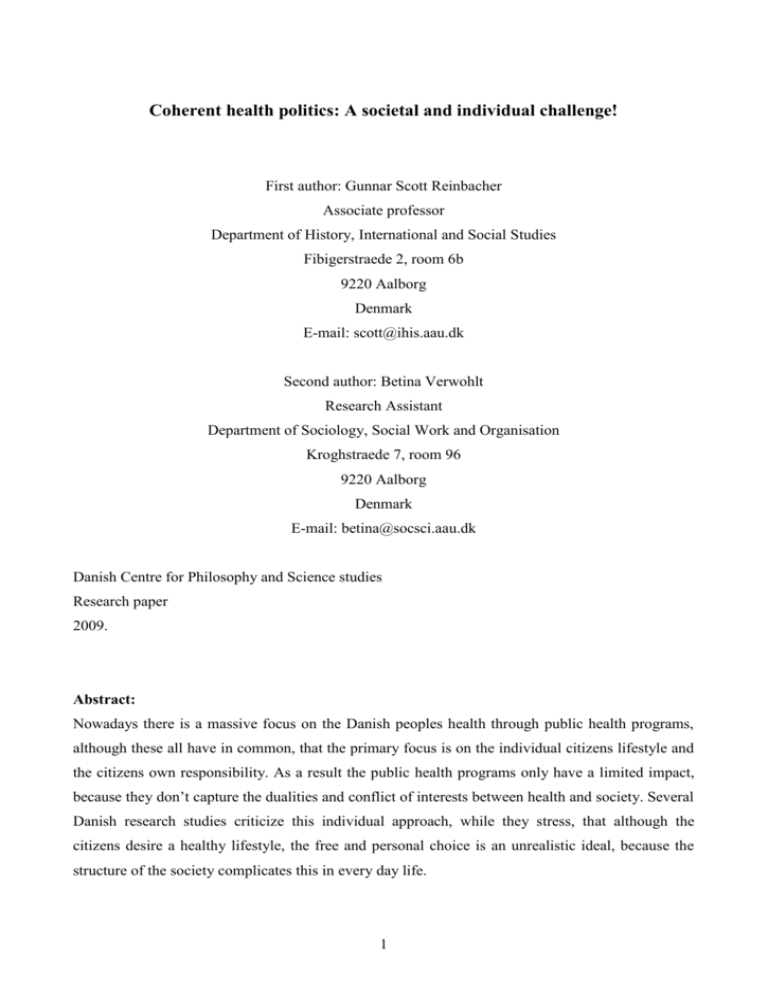
Coherent health politics: A societal and individual challenge! First author: Gunnar Scott Reinbacher Associate professor Department of History, International and Social Studies Fibigerstraede 2, room 6b 9220 Aalborg Denmark E-mail: scott@ihis.aau.dk Second author: Betina Verwohlt Research Assistant Department of Sociology, Social Work and Organisation Kroghstraede 7, room 96 9220 Aalborg Denmark E-mail: betina@socsci.aau.dk Danish Centre for Philosophy and Science studies Research paper 2009. Abstract: Nowadays there is a massive focus on the Danish peoples health through public health programs, although these all have in common, that the primary focus is on the individual citizens lifestyle and the citizens own responsibility. As a result the public health programs only have a limited impact, because they don’t capture the dualities and conflict of interests between health and society. Several Danish research studies criticize this individual approach, while they stress, that although the citizens desire a healthy lifestyle, the free and personal choice is an unrealistic ideal, because the structure of the society complicates this in every day life. 1 This article provides a twofold contribution to the health debate, because it first of all queries the fact, that in Denmark and Europe we address the health problems as the citizen’s individual responsibility and don’t focus on the structural barriers, which on the societal level complicates a healthy lifestyle. The present challenge, that the lifestyle diseases account for, in Denmark as well as the rest of the Western World, is being handled in a way, that the government through ‘governmentality management’ informs the citizens of the right health behaviour, and then leaves the responsibility for the citizens’ health to each individual. This perspective is exemplified in the newly published report from the Danish Prevention Commission. If we continue this narrowminded focus on the health problems, and fail to be aware of the societal barriers, which isn’t just the individual citizens’ but just as much the governments’ responsibility to suppress, we contribute to a continuous distortion in proportion to the health, and we will never suppress the lifestyle diseases. Secondly the article contributes with a proposal to a brand new sociological and societal way of comprehending health and health promotion. In this perspective the responsibility for the citizens health doesn’t only lay with the individual citizen, but is just as much a responsibility for the government, the industry and the relevant institutions. Only if we take a broader view on the public health, where we include all these relevant levels, we will be able to locate and problematize all the barriers that inhibit the public health. Case: The report from the Danish Prevention Commission The strategy in Danish healthcare in the latest decades has been a governmental strategy, in which The Danish government has initiated a number of researches and campaigns that focus on improving the health for the Danish population. The most recent of these researches is the report from the Danish Prevention Commission: “We can live longer and healthier: The Prevention Commissions recommendations towards a stronger prevention effort” published on April 21st. 2009.1 This paper contains a discussion of this report because it represents the direction of the Danish government’s contemporary strategy towards a healthier population. 1 The report is shown at: www.forebyggelseskommissionen.dk 2 According to the report the Danish average lifespan is still below the average of the OECDcountries. Because of this, the Commission was given the task to investigate how to improve the average lifespan of the Danes by three years within a ten year period. The report, like most Danish reports, focuses on a number of lifestyle factors that is important to the Danes’ life quality as well as the length of their lives. The most important of these lifestyle factors are described in the report as being smoke, alcohol, physical activity and diet. The new contribution in this report is according to the members of the Commission, that the government is recommended to govern the population in a more explicit way, and that the Danish population should get used to more prohibition and directions than exist today. ”If the government wishes to improve the health of the sickest part of the population, it is forced to deal with its own policy when it comes to the health and prevention situation. This is the distinct conclusion from the governments own Prevention Commission. ‘According to the Commission the idea that health is an individual responsibility and that it can be improved of one’s own free will must be replaced by prohibitions, taxes and more intervening in people’s life. This is what it takes, if the politicians wants to help the weakest’ says the head of the Commission, Mette Wier”2 This more explicit intervention into people’s life represents a new intensified agenda comparing to earlier researches and reports in the health- and prevention area, and this could represent the indication, that the relations between the government and the population is changing. This change composes the subject of this paper. What on the other hand isn’t new about the report is that the focus is still oriented towards the individual perspective, just like the majority of reports on the field. Because of that, the structural perspective on the health of the population is limited. The many reports on the field indicate that there is a massive focus on the health of the Danish people. Despite of this, the effect of the research programs and the reports and guidelines to the public has been limited so far if compared to other preventive initiatives. The reason seems to be, that the underlying ontology focuses on the individual as a free and powerful citizen who always has to be able to ‘poll him- or herself together’ and live a healthier life. It is this ontology - that only the citizen himself can be hold accountably for his way of life - that is reflected in the published reports in the field. 2 Our translation. Berlingske Tidende 1.5.2009 3 This ontology is failing to contribute to a healthier population, because without considering stratification mechanisms as the industry and the market it obligates the individual citizen for his or her own health. As a result the citizens and specially the poorest ones find it more than difficult to meet the ideals for a healthy life. According to this, the Danish think tank for the news expresses in a report on the field: “It took more than 30 years to reduce the number of people killed in traffic by three quarters. It took 25 years to reduce the schoolchildren’s holes in their teeth by three quarters despite an increasing consumption of sugar at the same time. Other changes in society – women’s liberation or the establishment of a constitutional state – are also changes that have been ongoing for many years. All these changes happened due to a number of initiatives which have slowly changed the fundamental rules, norms and behaviour in the society. No changes has occurred just because of informations about the consequences of individual choices” (Hede and Andersen 2006:9 – Our translation). According to this the States Institute for Public Health has in countless reports3 strongly proved the connection between the health actions of the population and the socio-demographic factors as age, gender, occupation, address and education. These are determinants that disproof the ontology of lifestyle illnesses solely as a result of the population’s individual and free choices. Another report published by the think tank for the news: “Mandag Morgen”4 shows a strong knowledge in the Danish population of the fact that we ourselves are responsible for our own health. But there is also a strong awareness that the personal willpower isn’t nearly enough to secure a healthy population. Only seven percent of the Danes disagree that the public sector must take a greater responsibility in securing safer conditions for the life of the population, and 36 percent believe that you are entitled to get help from the public sector to live a healthier life (Serpa et al 2008:7,54). The clear message from the reports mentioned above is, that the structural context has a huge influence on the Danish health and life expectancies and furthermore that the health of the population probably won’t be improved until the existing barriers will be located and problematized in a broader view. The accountability of the public health is simply too essential to be placed entirely on the individual citizen him- or herself. Instead a more efficient effort towards a healthier 3 4 The reports is shown at the webpage: www.si-folkesundhed.dk. The report is called: Fremtidens forebyggelse and is shown on the webpage: www.mm.dk 4 population includes a broader view in which health isn’t just a matter of the individual capabilities and determination but also includes a more structural perspective and more focus on the inequalities of health. The members of the Prevention Commission start to focus more on governmental interference in order to ensure the health of the population. Despite of that, and despite of the suggestions from the reports mentioned before, the Commission’s report only briefly mentions responsibility of the states itself responsibility to ensure the right context for the healthy population. The state ought to focus on ideas that deal with the structures of society, prices on food, supply, peer pressure and social relations. All of these initiatives would make it easier for the citizens to make healthier decisions. Also in another correlation the report is leaning towards existing researches in the field. This is done by focussing on rules and regulations. The focus is on eliminating the determinants which entails that the population live for a shorter time and have poorer health conditions while alive, although there is no focus on the life-lengthening factors. It is important to focus on eliminating the factors that causes a poorer quality of life and an early death for too many Danes, but a holistic effort must also consider the life-affirming and life-lengthening factors. One of these lifelengthening factors seems to be relationships between friends. One of the leading researches of how friendships affect the quality of life is a longitudinal investigation made in Australia in the period from 1996 to 20065. The research studied 1500 people, who were all 70 years old when the research began. The result showed that the elderly citizens who had more than 10 friends had 22 percent less risk of dying than those who had just five friends. Another example of the influence of friendships on the life quality is an American research of 3000 women with breast cancer. This research showed that the risk of dying from breast cancer was four times bigger for women without friends compared to women who had 10 friendships (Danish Newspaper: Urban 3.4.2009:6) In order to achieve an efficient preventive contribution, it is a necessity that the focus is both on the individual responsibility of the citizens as well as on the responsibility of the government and the market and that we focus both on eliminating the factors that shortens life as well as ensure the positive factors that enrich and lengthen it. 5 The Australian Longitudinal Study of Agening. 5 A consequence of the ongoing individualistic perspective could be a ‘blaming the victim’ perspective and a new prohibition-collective in which the citizens who fails to live in accordance to the health-ideal could be discriminated and excluded from the collective. Instead we have to build a balance between the state and the citizens when it comes to the health policy – a balance where not only the individual citizen but the state as well contributes to a healthier population. Critical views of the case of the Prevention Commission In ints conclutions the Prevention Commission distinguishes in its conclusions between regulation and prevention initiatives. The regulation represents the more governing part in which the government is expected to interfere. It consists of two parts: The first part addresses the government’s responsibility to increase taxes on unhealthy articles such as tobacco, alcohol, sugar and fat and to reduce taxes on fruits and vegetables. The second part consists of regulations to the citizens. For example regarding tobacco and alcohol. At the publication of the Commissions report the Secretary of health and the Secretary of Taxation almost eliminated the demands towards the state in regard to the government’s regulation, which indicates that the focus in practice exclusively is on an individual paradigm, in which the government mark out normative guidelines to the citizens together with the expectation that the citizens live in accordance with those guidelines. The reception of the Commissions report The media’s reception of the Commission’s report and the public debate about the report has been surprisingly harsh when is comes to the commissions conclusion about interfering in the free live and choices of the citizens. A counter culture arises around the demands, that the citizens won’t tolerate, that their degrees of freedom is being oppressed. This counter culture has probably surprised the Danish Health Ministry as well as the authors to the Commission report. As a consequence the government withdrew some of the more restrictive suggestions and it will probably be more careful in regard to these types of sanctions and demands in the future. If that is the case, we’ll have a report that doesn’t live op to the government’s demands of an initiative to increase the average lifespan by three years within a period of ten years. 6 It seems odd for a Ministry to produce a comprehensive report just to dissociate itself from its conclusions – conclusions that shoved a possibility to increase the average lifespan with three years. The problem of this project is that it is solely a matter of the Health Ministry. The project ought to be a common project in which a united Commission from a whole range of Ministries – and among these the Ministry of Taxation, the Ministry of Employment and the Ministry of Commerce – would gather. The problem of the average lifespan of the Danish population lies in the combination of the structural conditions that relates to those Ministries, and that is why the solution of the problem must be found here. There is hardly any doubt, that several of the members of the Commission would have wanted more focus on how the societal factors influence the average lifespan as well as more focus on the state’s contribution to a healthier population. The reason why the report only very briefly deals with these issues is a result from the conditions of the report. Is says in the report that the Commission must; “bring suggestions that are proven as well as cost-effective” (Forebyggelseskommissionen 2009:4 – Our translation). The outcome of the work of the Commission is determened by the economic boundaries, and this is probably a significant reason for the outcome. The Danish discourse The report from the Danish Prevention Commission: ”We can live longer and healthier” is placed in the individualistic discourse, which have characterised the Danish health policy though out the latest decades. There are a lot of other initiatives which can be placed in the same discourse. Among these are the non-smoking campaigns, the ‘30 minutes campaign’ which tells us to exercise at least 30 minutes a day, the ‘6-a day (fruits and vegetables) campaign’, the ‘what you eat is what you become’ campaign, the ‘choose wholemeal first’ campaign, the ‘14/21 consumes’ campaign that has the message, that women ought not to drink more than 14 drinks and men no more than 21 drinks a week, and many more campaigns. There is truly an abundance of campaigns which enlighten the Danish citizens on how they ought to live. All of these regulative campaigns of enlightenment constitute a ‘new’ discourse in the field of public health. 100 years ago the most widespread disease was the infectious diseases, which could be reduced or even eliminated by public initiatives as improved sanitary conditions, free vaccines for children, running water and so on. Today the most widespread diseases are the lifestyle diseases 7 as the infectious diseases are sharply reduced. This change in the type of the diseases ought to be matched by a change in the government’s health policy. As the lifestyle diseases, unlike the infection diseases, are multifactorial and complex, they can’t be eliminated just by introducing vaccines and better hygienic conditions. It is in the light of this change in the diseases the spread of the campaigns must be understood. The enlightenment campaigns can legitimately be considered as a new discourse and a new control mechanism, which is needed in order to handle these new diseases in Denmark as well as in the rest of the Western World. This discourse of campaigns, studies and recommendations are however only corresponding to one aspect of the new diseases, which is the citizen’s own responsibility in accordance to being able to govern their own life’s. This indicates, that ‘the Danish discourse’ is a discourse, which make demands and expectations to the citizens and regulates the freedom of the population. The ontology is, in this discourse, that the individual citizen, and not the market or the government, possesses the responsibility of the lifestyle diseases. This is a typical Danish view, which has existed for decades without any notable improvement in the health of the population. The governmental management and advanced liberalism The report from the Danish Prevention Commission is, as well as many other initiatives in the field, part of the Danish discourse, in which the government seeks to govern the Danish population toward a healthier life style. All of these initiatives have one thing in common; they all possess the same management technology which is the governmental management. The governmental management is: ”A particular power technology, that has the purpose to manage peoples self-management of their own life and behaviour. It presupposes the subjects as free actors, and that is how it differs itself from other power technologies such as violence and force” (Otto 1006:2 – Our translation). The governmental management is distinctive for the liberalistic paradigm, which in these years and decades permeate the political field in Denmark as well as great parts of the Western World. As opposed to earlier management technologies the citizens in the liberalistic ideology are seen both as object for the state as well as partners. This means, that the ontology of the liberalistic management technology is an ontology in which the citizens are free and expected to act rationally. The 8 precondition for the governmental management is both a disciplinary process and a civilized process. ”The possibilities for liberal forms of freedom may historically depend upon the exercise of discipline. Freedom, in a liberal sense, should not be equated with anarchy, but with a kind of well-regulated and ‘responsibilized’ liberty. The task, according to Foucault, was not to denounce the idea of liberty as a fiction, but to analyze the conditions within which the practice of freedom has been possible” (Barry, Osborn & Rose 1996:8). In the western countries democratic management technologies, especially in the liberal orientation, is tied to specific management strategies that appears as in the Danish Prevention Commission. These management strategies seek to initiate networks of self-governing citizens, which the state is able to influence through these studies, recommendations and campaigns. The advances in liberalistic management technology is not to be understood as a narrow political view, but it is a management form, which is an underlying mentality in great parts of the society and is encouraging the population to self-management and self-monitoring (Otto 2006:14). In this view, the report from the Danish Prevention Commission is completely in agreement with the liberal project. The goal with the self-management isn’t just to keep the individual citizen healthier. It is just as much something, that the citizen ‘owes’ the society. By complying with the Commission’s recommendations the population will achieve not just a healthier and longer life, but just as important a healthier population means a financial profit in proportion to decades of acceleration in the health expenses. This leads us to the subject of this article, which is, that the relationship between state and citizens are changing in the ages of the new liberalistic management. The ontology in the liberalistic management technology is an ontology where the population consists of powerful and calculated citizens and that it is only fair to demand of them, that they comply with a healthy life style – not just for their own gain, but just as much for the profit of the society. The governmental management is sophisticated because it focuses both on the freedom of the individual citizen as well as on the citizen’s responsibility to live in compliance to the norms of the society. Compared to earlier and more direct types of management the governmental management is 9 also an advanced and obscure form of management. The reason for that is, that the power isn’t centralized at only one authority, but is omnipresent. Professor Lene Otto writes in this correlation: ”The welfare policy is a particular tricky combination of political power exercised on legal subjects and pastoral power exercised on living individuals (Foucault 1988:67). Because of this, the management is embedded in techniques and procedures that seem to be a part of the way, the institutions are designed. These kinds of power don’t appear to have any subject, towards which the opposition can turn against” (Otto 2006:14 – Our translation). You can, according to the report from the Prevention Commission, and the Danish context, which the report is placed in, say that the governmental management only seeks to regulate the population and doesn’t address the responsibility of the state and the market. The purpose of this article is to contribute to a new focus on the health of the Danes - a focus that doesn’t dazzle the individual with the advanced management technologies, but where the citizen as well as the state and the market are involved and held responsible. Only when all these three levels are addressed, the efforts toward a healthier population will truly be accomplished. The necessity of a new paradigm, a new ontology and a new discourse It is necessary to produce a counter culture to the existing paradigm, which solely addresses the individual citizen when it comes to the population’s way of life. The citizens don’t live in a vacuum, but are part of a social, economic and political environment that constantly sets conditions, boundaries and limitations for their lifestyle and contributes to the conditions of a sick or a healthy life. These conditions aren’t the same for all the citizens, but are determined by the social and geographic stratification that distinguishes between socioeconomically advantaged and socioeconomically disadvantaged citizens. By maintaining that the citizens aren’t the only ones responsible for their own health, can by some groups be seen as unorthodox, as an attempt to disclaim ones own responsibility and as a way of saying, that the society must pay for ones own inadequacy. It is deeply rooted in the modernity, that ‘everyone is the master of one’s own fate’ and that we are completely free to make decisions concerning our own health. We are used to think of health as a matter of willpower but that is an incorrect assumption. The society sets the conditions of our lives. The political and economic systems are constantly interacting, and there is a constant dialogue, contradiction and conflict of 10 interests between the citizens and the structural conditions of the social life. Only by comprehending this management discourse, we as individuals live in, we are able to understand the mechanisms, which create social inequality and sickness in the modern society. We suggest a new dynamic model which, as shown in figure 1, is more holistic because it addresses multiple levels in connections to the health policy. The levels are, besides the citizens, the state, the industry, the municipality and different institutions. Figure: A coherent perspective The industry (the pharmaceutical industry) The state Public health and barriers for public health The municipality The citizens and civil society Institutions It is these levels which, among others, constitute the structural arena, in which the population acts and it is necessary, that these levels are managed in a way, that they support a healthy population and don’t work against it, as it is the case today. When the secretary of health strives towards solutions that are cost-effective, and puts it as a requirement to the Prevention Commission, this requirement creates its own contradiction, which is expensive solutions, because the solutions don’t get to the bottom of the structural mechanisms that create diseases. The short-termed requirement of economic neutral solutions is the condition that creates the expenses in the long term. One example according to this is the chronic disease ‘diabetes II’. The assumption is that the number of people who catches this disease will double in less than ten years in the Western World. Obesity is another similar problem. We know that diabetes isn’t just self-inflicted torment but a result of many complex connections in the way the society is designed, the way we work and the 11 food we eat. In other words all the characteristics that is in the daily life conditions. We also know that these characteristics vary according to the financial development and the different cultural traditions. In Vietnam, one of the fastest growing economies in the world, is it estimated that 16 percent of the population in the capital city Hanoi suffer from diabetes. The percentage is significantly lower in the less developed areas, the mountains and the villages. Vietnam has undergone a total change in economical terms. Just five years ago the most common means of transport was the bike. Today it is replaced by cars. At the same time changes has happened to great parts of the population, whose working conditions have changed from physically active work to more sedentary work. This shows that it is the same economic growth, as seen in the Western World, which now shows in the eastAsian societies, and also here creates the disease-structures of the modern society. This is why it is absolutely necessary to acquire a new discourse that has its focus on the complicated connections between these societal structures, social living conditions and the life patterns of the citizens. This new discourse won’t be easy to implement, because of the Danish tradition that everyone is the master of one’s own fate. Focus was in the 1960’s and 70’s on trying to find the societal causes that determines the health of the population. Focus has changed in the 21st Century which means that we now almost exclusively focus on the citizen’s own responsibility towards staying healthy. In the same manner there is a tendency to miss the social inequality in health (Hede and Andersen 2006). With this article we seek to settle with those polarised conceptions, as we introduce a model (figure 1), that includes the state, the market and the citizen – or put in other words: It both includes the individual operators as well as the structural conditions in order to achieve a healthier population. A new health policy? In their report: ”Commission on Social Determinants of Health: Closing the gap in a generation, Health equality through action in the social determinants of Health” the World Health Organisation (WHO) brings a sustainable suggestion to the focus areas, that must be prioritized in order to reduce the inequalities in health and to achieve a healthier population, which is the declared goal of the report (WHO 2008:248). WHO turn the problems around compared to the Danish discourse, as they 12 don’t recognise health exclusively as being the citizens own responsibility, but also considers the responsibility of the political and economic systems. WHO demands that the national governments and economies come up with a solution to this problem. Under the following headlines some very concrete and necessary initiatives are stated: WHO: Equality from the start Healthy places - healthy people Fair employment and decent work Social protection across the life course Universal health care Health equality in all policies, systems and programmes Fair financing Market responsibility Gender equality Political empowerment, inclusion and voice Good global governance Social determinants of health: monitoring, training and research (WHO 2008: 202-206). These are, according to WHO, the key points in a new, global health policy. As shown the headlines don’t address the responsibility of health, solitarily as an individual responsibility, but as a global responsibility, that also includes the national governments and economies. WHO also points out, that the development from the individual to the societal orientation and discourse is a difficult process, which requires great effort and a lot of research. It could take years before it is natural to speak of public health as mainly a responsibility of the society. WHO has developed a conceptual framework of the social health determinants (WHO 2008:43). 13 Figure 2: Commission on Social Determinants of Health conceptual framework (Source: Amended from Solar & Irwin, 2007) With this model the WHO don’t just develop a new model for analysis, but they also develop new principles for action on a global level. These new principles are: 1. Improving the conditions of daily life – the circumstances in which people are born, grow, live, work and age. 2. Tackling the inequitable distribution of power, money and resources – the structural drivers of those conditions of daily life – globally, nationally and locally. 3. Measuring the problem, evaluate actions, expand the knowledge base, develope a workforce, that is trained in the social determinants of health, and raise public awareness about the social determinants of health (WHO 2008:43). 14 The conceptual framework is a macro model although it opens the possibility of configuration and operationalisation. Because of this, the model is also very useful in a national, regional and local context. The material conditions, the societal connection, the psychological factors, acts and biological factors are all both structural conditions and more dynamic variables for conditioning the dynamics of health. The biological factors are estimated to have a more dominant importance in the public health and the comprehension of sickness in the 21st Century (Rose 2009). In total, the two parts in the middle of the model represent the structural and the dynamic part in a sociological analysis. The socioeconomical and political contexts constitutes the global, national and local freedom to act in order to generate health, but it also constitutes the limitations and the prioritizing of health. The sociological parameters can have a tendency to give an apolitical understanding, but the dynamics of a policy analyse creates an orientation towards the comprehension of differences in health and sickness in the different national systems. Therefore the policy analysis can become an important key when it comes to analyzing the dynamics of creating a new context for a healthier population. The sociological analysis of the new discourse of health can’t stand alone, but will benefit by being included in a dialogue with the policy analysis. The dynamics between the sociological analysis and the policy analysis can identify the determinations that create the allocation of public health and the fight against diseases that exist in the globalised world today. The social epidemiologist Richard Wilkinson has been concerned with the WHO analysis (Wilkinson 2005). According to this Wilkinson asks the questions: ”Why do people in more unequal societies have worse health and shorter lives?” and “Why are levels of violence higher, and community life weaker, where there is more inequality?” (Wilkinson 2005). Wilkinson analyzes how inequality affects the social relations and the everyday life of the population. In the rich countries health isn’t just a matter of having access to material goods and the health systems. It seems that it is also a matter of the citizen’s social relationships and social positions, which also, to a great extend, is determining the life conditions 15 “Recent research has revealed that some intensely social factors are among the most important determinants of health in the rich countries. These include the nature of early childhood experience, the amount of anxiety and worry that we suffer, the quality of our social relationships, the amount of control we have over our lives, and our social status. By choosing which dimensions of health we look at and what angle we look at them from, we can choose what aspects of life health tells us about.” (Wilkinson 2005:9). The model of WHO (figure 2) is a macro model, but Wilkinson’s model is more operationalized. A more economic and political model, that establishes a connection between social inequality and social destruction. Figure 3 shows Wilkinson’s model: Figure 3: The effects of income inequality (left-hand side) on social and psychological wellbeing (right-hand side) (Wilkinson 2005:23). The strength in Wilkinson’s model, which is supported by data from a whole range of countries throughout the world, shows step by step how the growing financial inequality and the relative poverty creates greater differences in the social status of the population, which means that family relations are broken down. This leads to less involvement in the social life, which creates stress and depression and in connection to this health problems, problems with alcohol and social behaviour. All of this leads to a social disability. The root of all this is the economic and social inequality. Wilkinson’s model is an example of a configuration (the variables) and an operationalization (the indicators of an empirical analysis) of a very complex problem. The model shows how the social inequality doesn’t just reproduce itself but also accumulates social inequality and exclusion from the society. 16 The model problematizes what can be done about the social inequality. A question many scientists have tried to answer. For Wilkinson the most important issue is political will.” (Wilkinson 2005: 302). He writes: “What matters in the developed world today is the social environment: it is only by improving the quality of social relations that we can make further improvements in the real quality of our lives. Fortunately, the quality of the social environment is not simply a matter for individual wishful thinking or individual commitment to higher moral standards: it is instead built on material foundations. Practical policies affecting how we run the economy and how the organizations we work in function provide powerful policy handles with which to influence the nature or social the.” (Wilkinson 2005:314). Wilkinson’s model is central to the analysis of the public health. The model questions the development in the social relations. According to Wilkinson, it is necessary to create social changes that reduce social inequality and social exclusion. This is an accumulative change in society that creates better living conditions in the modern societies. This is why the model can be understood as a counter discourse in accordance to the existing Danish discourse on public health. The necessity of new research and a new knowledge The focus areas of WHO, and specially the involvement of the structure perspective, is a significant contribution toward a new and more holistic health policy. Still, we need new knowledge about the relations between the state, the citizens and the market according to the public health. Especially we need studies that prove not only the determinant, that deteriorate and shortens the lives of the Danish population, but also the determinants that enriches and lengthen lives, as the earlier described relations between friends. In this way there is need for a research, that is holistic at several levels, and that involves both the individual citizen and the state as well as focuses both on the factors, that affects the health of the population in a negative way, but just as much on the positive factors, that improve the health of the population. Although it is challenging, it is possible to apply the models, presented in this paper, in a new discourse towards a healthier population. The models are powerful and useful eye openers for the 17 comprehension of the public health in Denmark. They are also a critique of the existing health policy, as it has been presented in the report of the Prevention Commission. The health sociology as a ‘new’ discourse The health policy is at the same time both new and old. Ludwich Fleck was born in Poland in 1896, and was originally a physicist. At the same time, though, he also studied medicine, and he viewed the public health as a protest against the more medical approach, that didn’t accept the relations between health and society. To Fleck, the medicinal science was a product of society. He analyses how different societies at different stages of development produces different kinds of deceases (Fleck 1979,1981). Fleck’s work was path breaking, because as early as the beginning of the 20th century it had a sociological comprehension of the relation between the structures of society and the public health. After World War II, one of the greatest American sociologists, Talcott Parsons, engaged himself in the medical discussion of health and sickness, and especially into the term ‘the sick-role’ (Parsons 1950,1958). In the period just after World War II, there was a huge need for equilibrium theories6. According to this, Parsons’ comprehension of medicine are stated as ’sociology in medicine’, which means that the role of the sociology was inside the existing medical paradigm – and not challenging this paradigm. According to Parsons, it was necessary to provide explanations and solutions that maintained status quo. This meant that the sociology in medicine was subordinated to the medical science as a discipline The real break through of the sociology, came with the debate of the psychiatry in the 1960’s and 1970’s, in the light of Lains anti-psychiatric debate. At the time, the societal explanation of the psychiatric patients became the top of the agenda, and that encouraged the sociology of health. Among others Foucault grasped this discussion (Foucault 1963, 2000) as he developed the ’sociology of medicine’. The sociology of medicine indicates that diseases are now caused of societal sickness, just as Fleck already described it in the start of the 20th Century. The difference is, however, that the explanations now are more varied when it comes to social inequality, social 6 Equilibrium theories are theories, that expresses stability and an assumption that situations that challenged this stability (equilibrium) was always negative. This view ment, that Parsons couldn’t explain social changes, since the developments of structure was negative. 18 classes, gender and ethnicity. Fleck didn’t articulate these variables, in the way they were articulated now. Another sociologist: Graham Scambler (2002) moves beyond the descriptive models as he takes a more critical position, as regard to the development of the society. He even moves beyond the agenda of WHO, as he addresses the necessity of a new critical sociology of health: ”The moral character of critical sociologists’ commitment to life world rationalization entails an additional commitment to forums of deliberative democracy via the institutionalization of discourse-ethical procedures in the public sphere of the life world” (Scambler 2002:153). This means that public health isn’t just an individual problem, but a societal issue that is of relevance to us all. It isn’t enough to describe the relations between health and society. We also need to act, and we need to act as a collective and act as an ethic step to improve the living conditions for the citizens. WHO shows the way in this process, and Scambler shows a more critical sociological approach to the structural changes in modern societies. References Fleck, Ludwik (1935 (1979)): The Genesis and development of a scientific fact, Chicago University Press. Fleck, Ludwik (1935(1981)): On the question of the foundations of medical knowledge. Journal of medicine and philosophy 6: page 237-256. Forebyggelseskommissionen (2009): ”Vi kan leve længere og sundere”, Sundhedsministeriet. Foucault, Michel (1963, 2000): Klinikkens fødsel, Hans Reitzels forlag. Hede, Anders og Andersen, Jacob (2006): ”Er sundhed et personligt valg? – Et debatoplæg om forebyggelse i Danmark. Huset Mandag Morgen og Trygfonden. Kamper, Jørgen Finn og Almind, Gert (2001): ”Forebyggende sundhedsarbejde”, Munksgaard 19 Otto, Helle 2006: ”Foucaults ’governmentalitetsteori.’ Styringsteknologi og subjektivitet. Arbejdspapir, 1. udkast. Parsons, Talcott (1950): The social system, Glencoe, Free Press. Parsons, Talcott (1958): “The definitions of health and illness in the light of american values and social structure” in: “Patients, physicians and illness”, edited by E. Jaco. Chicago Free Press. Rose, Nikolas (2009): Livets politik, biomedicin, magt og subjektivitet i det 21 århundrede. Dansk Psykologisk Forlag. Scambler, Graham (2002): Health and social change, A critical theory. Open University Press, Buckingham. Serpa, Lene et al (2008): ”Fremtidens forebyggelse – ifølge danskerne.” Huset Mandag Morgen og Trygfonden. White, Kevin (2002): An introduction to the sociology of health and illness. Sage WHO, Commission on Social Determinants of Health (2008): Closing the gap in a generation, Health equity through action on the social determinants of Health. WHO library. Wilkinson, Richard G. 2005: The impact of inequality, how to make sick societies healthier, Routledge. 20

